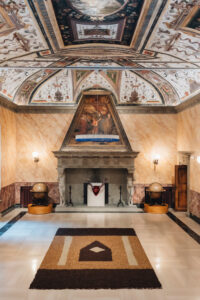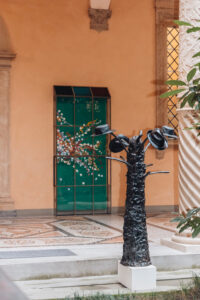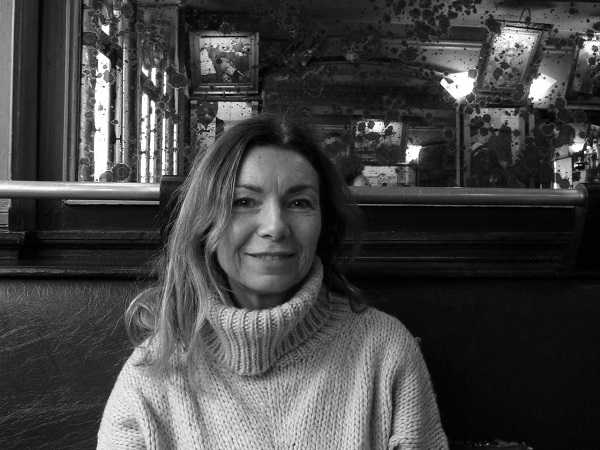It is not easy to imagine a fascinating space like that of Palazzo Boncompagni, if you have never visited it, since it is one of the most surprising Renaissance buildings in Bologna, built to house a pope. Equally it can be said that the current show by Aldo Mondino, “Impertinenze a Palazzo”, held in the same Palazzo Boncompagni, curated by Silvia Evangelisti and promoted by Paola Pizzighini Benelli, is one of the most amazing of this Bolognese season. Opened during Arte Fiera 2023, the exhibition presents an important collection of heterogeneous works that testify to the artist’s intense career, realized thanks to the collaboration with the Aldo Mondino Archive, founded in Milan by his son Antonio Mondino together with Emilbanca.

Aldo Mondino, Impertinenze a Palazzo, exhibition view, Palazzo Boncompagni, second half of the 16th century, Papal Audience Hall on the ground floor, 2023. Ph. Marcela Ferreira, courtesy Palazzo Boncompagni and Archivio Aldo Mondino
The title of the exhibition refers to the impertinence of the artist and his eccentric singularity, his outstanding dandy figure, his paradoxical and playful inventions, which this precious exhibition brings back and evokes also through some iconic photos, such as that of artist riding a camel in via Brera under the “controlled traffic area” sign. Aldo Mondino (Turin, 1938 – 2005) was one of the most eclectic and irreverent international masters of the 20th century, a tireless innovator but also a profound connoisseur of art, active from the years of Pop Art and Arte Povera but not attributable to a specific trend.

Aldo Mondino, Mekka Mokka, 1988. 100 kg of coffee beans and drawing on dust paper, 220 x 140 cm. Papal Audience Hall. Ph. Marcella Ferreira, courtesy Palazzo Boncompagni and Archivio Aldo Mondino

Aldo Mondino, Gerusalemme, 1988, bronze, 164 x 110 cm. Aldo Mondino, Serra, 2004, oil on lino, glass and iron, 198 x 130 cm. Ph. Marcella Ferreira, courtesy Palazzo Boncompagni and Archivio Aldo Mondino
The show, as Antonio Mondino suggests, represents «an operation of re-reading that sets up an unprecedented path» and it properly works for the extraordinary contrast and dialogue between the works and the place. Starting with the first magnificent audience hall of Pope Gregory XIII – precisely during the same year of the celebration of the 450th anniversary of the pontifical appointment – one is welcomed by “Mekka Mokka”, 1988, a large carpet with a geometric design, made with 120 kg of coffee beans of three different colors, which alludes to the Islamic prayer rug. Under the imposing fireplace by Pellegrino Tibaldi the irreverent and mischievous sculpture in glass and bronze “Trofeo”, 1996, stands: two legs spread apart in a V shape with self-supporting stockings and stiletto heels. Another iconic and light work, “Jugen Stilo”, 1993, descends from the frescoed ceiling, a chandelier made of Bic biro pens that simulate crystals, and wrought iron. A piece that was already exhibited at the 1993 Venice Biennale curated by Achille Bonito Oliva.

Aldo Mondino, Jugen Stilo, 1993. Iron wire and Bic biro pens, d. 140 cm. Private collection: Bologna. Ph. Marcela Ferreira, courtesy Palazzo Boncompagni
Silvia Evangelisti explains in the essay in the catalogue: «In his multifaceted artistic work Mondino intended to “act” directly on the normality of life. Within this work Mondino brings into play the subtle instrument of irony. Irony that Is expressed in particular in the titles of the works but not only. Creating wonder, highlighted by the choice of the materials and their magical manipulation». In fact, regarding the original use of materials, next to the “Mekka Mokka” carpet, which “acts” also through the aroma of coffee, we find “Scultura un corno”, 1980, made with chocolate that depicts four elephants one on top of the other. In another room of the Palace there is the work “The Byzantine World”, 1993, chocolates on panel with brilliant colors like those of the mosaics, which depict a sacred Byzantine architecture, or, proceeding, “Eldorado”, 2000, with Peyrano chocolates that reproduce the beauty of the New York skyline.

Aldo Mondino, The Byzantine World, 1999. Chocolate on panel, 190 x 240 cm. Ph. Marcella Ferreira, courtesy Palazzo Boncompagni and Archivio Aldo Mondino
The mosaic that the artist created with chocolates or sugar cubes is part of Mondino’s experience: in 1959 he moved to Paris to study art and painting at the Ecole du Louvre, but he also followed a mosaic course at the Parigi Fine Arts Academy with Gino Severini. In his entertaining “Aldobiography” the artist recounts that «his friendship with Tancredi and the meetings with Jouffroy, Errò, Lebel, as well as with the already established masters Matta and Lam» were crucial for his growth. After the first period in Paris, where he exhibited in various galleries, he came back to Italy in 1961 and the meeting with Gian Enzo Sperone was important as he exhibited the series “Tavole anatomiche”. From 1972 he returned to Paris until 1980. His ability to play with art, desecrating and decontextualizing with the ambiguity of language, is also evident in the “Mon Dine” self-portrait, in which he depicts himself in a red dressing gown in the manner of Jim Dine, or even in the bronze sculpture “La mamma di Boccioni”, 1992, (also one of Juliets’s covers) where the female figure has two large bowling balls instead of breasts. The magic of his world also derives from his numerous travels to the East and to other cultures including the life of the various religious traditions: the Jewish one of the rabbis that is present in the exhibition with the work “Gerusalemme”, 1988, a bronze trunk with the typical hats of the orthodox Jews hanging on the branches, the Islamic one with its famous carpets, such as the work on display “Tappeti stesi”, 1993. In Spain he was then enchanted by the elegant movements of bullfighters in bullfights, while in Turkey and in Cappadocia he discovered the prayer dances of the dervishes and the typical clothes of the merchants.

Aldo Mondino, Viole d’amore, Palazzo Boncompagni, second half of the 16th century, the lodge. Ph. Marcela Ferreira, courtesy Palazzo Boncompagni and Archivio Aldo Mondino
In difficult times like ours, who knows what Mondino would still produce with his irony and his imagination! An “incurable rebel” yes, but I would also add, having met and seen him a few times in Milan, a unique, amusing and unforgettable character, one of the masters with a big, vibrant and “romantic” heart.
Manuela Teatini
Info:
Aldo Mondino, Impertinenze a Palazzo
curated by Silvia Evangelisti
30/01/2023 – 16/04/2023
Palazzo Boncompagni
via del Monte 8, Bologna
palazzoboncompagni.it

Manuela Teatini, film maker and journalist, focuses on visual arts, in particular cinema, photography and contemporary art. She has written freelance for years with VOGUE, Uomo VOGUE, ELLE and other cinema, art and new trend magazines. She is the author and director of the docufilms “ART BACKSTAGE. La passione e lo sguardo” (2017),” MASSIMO MININI. Story of a Gallerist “(2019),” GIOVANNI BOLDINI. Il Piacere. Story of the Artist” (2021) awarded at the Terra di Siena International Film Festival 2021.






NO COMMENT